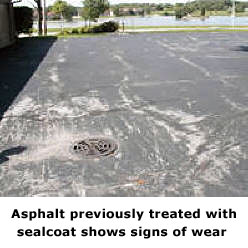Concrete Produces No Toxic Run-Off
Study Shows Asphalt Sealcoat Poses Environmental Threat
Reduces Heat Island Effect | High Albedo | Local Manufacture | No Toxic Runoff | Supports Recycling
PAHs and Coal-Tar-Based Pavement Sealcoat Update from USGS
New Sealcoat Fact Sheet from USGS (February 2011)
 According to a recent study in Texas by the U.S. Geological Survey National Water-Quality Assessment (NAWQA) Program and the City of Austin, the black emulsion sealcoat applied to asphalt pavement has extremely elevated concentrations of polycyclic aromatic hydrocarbons (PAHs) and can significantly affect the quality of downstream water resources. PAHs are known to have adverse health effects on animals, plants and people. Small particles of sealcoat flake off as they are abraded by vehicle tires, and can wash into urban streams with rain and runoff. The study found that particles in runoff from coal-tar based sealcoated parking lots have PAH concentrations that are about 65 times higher than in particles washed off parking lots that have not been sealcoated. Particles in runoff from parking lots sealed with asphalt-based sealcoat, the other major product on the market, have PAH concentrations about 10 times higher than those from unsealed lots.
According to a recent study in Texas by the U.S. Geological Survey National Water-Quality Assessment (NAWQA) Program and the City of Austin, the black emulsion sealcoat applied to asphalt pavement has extremely elevated concentrations of polycyclic aromatic hydrocarbons (PAHs) and can significantly affect the quality of downstream water resources. PAHs are known to have adverse health effects on animals, plants and people. Small particles of sealcoat flake off as they are abraded by vehicle tires, and can wash into urban streams with rain and runoff. The study found that particles in runoff from coal-tar based sealcoated parking lots have PAH concentrations that are about 65 times higher than in particles washed off parking lots that have not been sealcoated. Particles in runoff from parking lots sealed with asphalt-based sealcoat, the other major product on the market, have PAH concentrations about 10 times higher than those from unsealed lots.
November 2008 Update: Follow-Up Report by Authors of Austin, TX Research
"We reported in 2005 that runoff from parking lots treated with coal-tar-based sealcoat was a major source of polycyclic aromatic hydrocarbons (PAHs) to streams in Austin, Texas. Here we present new data from nine U.S. cities that show nationwide patterns in concentrations of PAHs associated with sealcoat."
September 2006 Update: Two Senators Urge EPA to Study Asphalt Sealant Runoff
Sens. Jim Jeffords (I-Vt.) and John Warner (R-Va.) have asked EPA Administrator Stephen Johnson to conduct studies on how sealants commonly used on asphalt pavements increase concentrations of toxic substances (polycyclic aromatic hydrocarbons—PAHs) in watersheds, and how such contaminants affect human health and the environment. Studies from the U.S. Geological Survey (USGS) over the past two years have shown that the chemicals can cause cancer in humans and kill aquatic life in high concentrations. The substance has long been associated with lung cancer among roofers and asphalt workers, according to the National Institute of Environmental Health Science. (Based on a report by E & E Daily.)
![]() Click Here to View the Report (PDF) This article is based on reporting from the 2 following websites:
Click Here to View the Report (PDF) This article is based on reporting from the 2 following websites:
![]() Study Finds Parking Lot Sealcoat May Be Major Source Of PAHs (Science Daily article)
Study Finds Parking Lot Sealcoat May Be Major Source Of PAHs (Science Daily article)
![]() Parking-Lot Sealcoat: A Major Source of PAHs in Urban and Suburban Environments (USGS)
Parking-Lot Sealcoat: A Major Source of PAHs in Urban and Suburban Environments (USGS)
![]() Click here for US Geological Survey website PAHs and Coal-Tar-Based Pavement Sealcoat Summary
Click here for US Geological Survey website PAHs and Coal-Tar-Based Pavement Sealcoat Summary
![]() Studies: Health risk from toxic pavement sealant greater than previously believed
Studies: Health risk from toxic pavement sealant greater than previously believed


